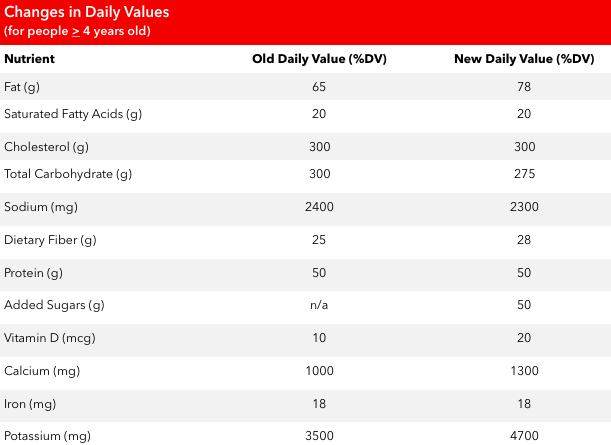Nutrition Label Update: Get More from the Label
The recent updates to the nutrition facts label show off a new, cleaner design that’s meant to make it easier to quickly identify useful information. The updates also reflect the most recent scientific research on the links between food choices and chronic disease so that you can make healthy, great-tasting choices for you and your family.Serving sizes have been updated to reflect the amount we actually eat. For example, the serving size for ice cream used to be ½ cup; now it’s 2/3 cup. This doesn’t mean that we’re encouraging you to eat larger amounts of ice cream, simply that most people routinely eat more than ½ cup of ice cream. In my mind, this change is highly problematic for people who are trying to lose weight and can benefit from guidance on portion sizes. The serving size information is important because all of the nutrient information is based on the serving size. However, that doesn’t mean that you can’t decide to eat a different size portion.Remember food labels that stated the package contained 1.5 servings? Those days are gone. Foods in packages with between one and two servings that people typically eat in one sitting, such as a 15-oz can of soup, now will be labeled as one serving. Foods such as pints of ice cream that could be consumed in one sitting but are larger than a single serving must now provide “dual column” labels indicating both “per serving” and “per package”/“per unit” amounts of calories and nutrients.The word “CALORIES” is now much larger, making it stand out on the label so that it’s easier to quickly see the number of calories per serving.The statement “calories from fat” is no longer on food labels because the most current science shows that the type of fat we consume (saturated, unsaturated or trans fats) is more important than the amount of fat.A new line for “Added Sugars” is an important change, because now consumers can clearly identify the amount of added sugars in foods. Added sugars include sugars that are either added during the processing of foods (such as adding sweetener to yogurt, cookies, or fruit drinks), or are packaged as such (e.g., a bag of table sugar or jar of honey). Added sugars include the sugars from syrups and honey, and sugars from concentrated fruit or vegetable juices. The research on added sugars clearly shows a strong link to developing cardiovascular disease, some types of cancer, type 2 diabetes, and obesity. The grams of added sugar per serving are now listed on the food label along with the percent Daily Value (%DV) which is set at a maximum of 50 grams per day, reflecting the 2015-2020 Dietary Guidelines for Americans recommendation of no more than 10% of daily calories from added sugar.The %DV is based on consuming 2000 calories per day, and is designed to give consumers quick, practical, and usable information to make healthier food choices. For nutrients to consume in smaller amounts: total fat, saturated fat, trans fat, cholesterol and sodium; choose foods that contain 5% of less of the %DV more often. For nutrients to consume in larger amounts: fiber, vitamins and minerals; foods with 10-19% of the %DV are considered a good source of that nutrient, while foods with 20% or more of the %DV are an excellent source of that nutrient. Remember that all nutrient information is based on the serving size.The list of vitamins and minerals on food labels has been updated to reflect changes in American’s food choices and eating patterns. Vitamins A and C are no longer required since most Americans consume adequate amounts of these nutrients. Vitamin D and potassium are newly added to the label because many Americans do not consume adequate amounts of these nutrients. The actual amount (in milligrams or micrograms) in addition to the %DV must be listed for vitamin D, calcium, iron, and potassium. Other vitamins and minerals may be listed, and both the actual amounts and the %DV must now be on the label.The daily recommended values for nutrients has also been updated based on the latest scientific evidence.Foods marketed specifically to infants through age 12 months, children age 1 to 3 years, and pregnant and lactating women now have %DV that reflect nutrient recommendations specifically for these groups. In the past, the %DV on all foods was based on the nutrient needs for adults and children age 4 and older. Source: Adapted from the Food and Drug Administration’s Final Rule “Food Labeling: Revision of the Nutrition and Supplement Facts Labels,” pages 903–906, and “Guidance for Industry: A Food Labeling Guide (14. Appendix F: Calculate the Percent Daily Value for the Appropriate Nutrients).”* **By Lynn Grieger, RDN, CDE, CPT, CHWCReferences:
Source: Adapted from the Food and Drug Administration’s Final Rule “Food Labeling: Revision of the Nutrition and Supplement Facts Labels,” pages 903–906, and “Guidance for Industry: A Food Labeling Guide (14. Appendix F: Calculate the Percent Daily Value for the Appropriate Nutrients).”* **By Lynn Grieger, RDN, CDE, CPT, CHWCReferences:
- U.S. Food and Drug Administration. The New and Improved Nutrition Facts Label – Key Changes. https://www.fda.gov/files/food/published/The-New-and-Improved-Nutrition-Facts-Label-%E2%80%93-Key-Changes.pdf published January 2018, accessed 5-29-19
- Today’s Dietitian. The New Food Label: What RDs Need to Know. Jessica Levings, MS, RDN. https://www.todaysdietitian.com/enewsletter/enews_0516_03.shtml accessed 5-31-19
*The old DVs were based on Adults and Children > 4 years old. The FDA’s final rule also set DVs specifically for foods marketed to infants through 12 months, children aged 1 to 3, and pregnant and lactating women. This means that the food label on foods marketed specifically to children aged 1 to 3, for example, will have % DVs specific to these age groups.**The old label listed vitamin D in IUs. The new label requires listing vitamins and minerals in micrograms or milligrams. For vitamin D, IUs still may be voluntarily declared in parentheses behind the microgram amount.